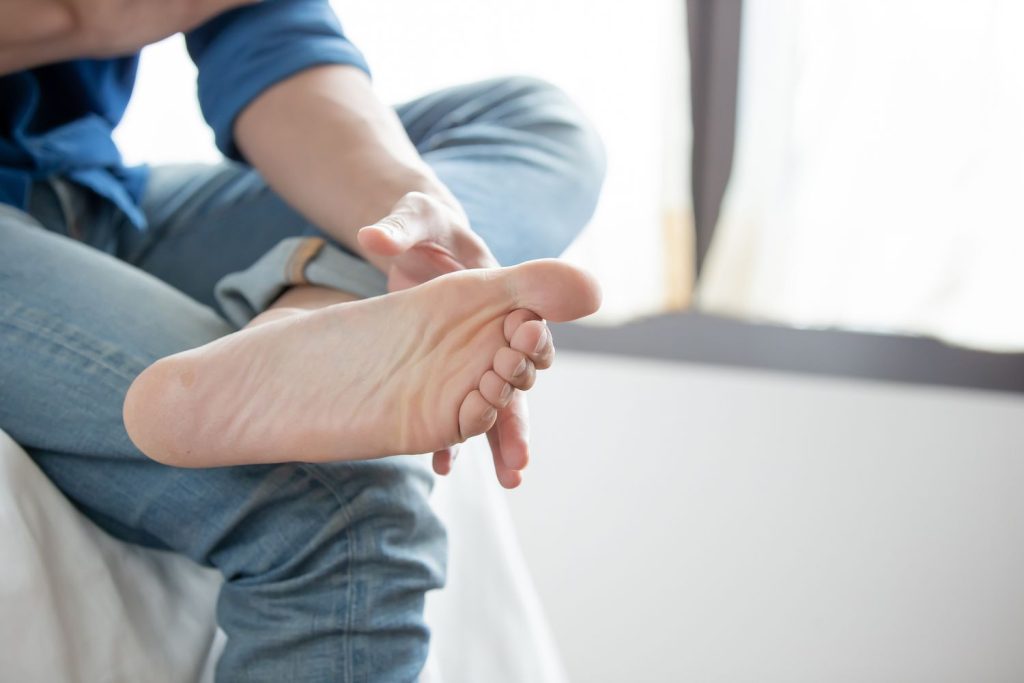Athlete’s foot, or tinea pedis, is a common fungal skin infection that can occur on any part of the foot but most commonly happens in the spaces between the toes. Symptoms include red, swollen, peeling, and itchy skin in the affected areas, as well as blisters in severe cases.
Athlete’s foot won’t usually go away without treatment. Although numerous well-known home remedies claim to treat athlete’s foot, only a few have research backing them up.
Reproduced with permission from ©DermNet NZ dermnetnz.org 2022.
Reproduced with permission from © DermNet and © Raimo Suhonen www.dermnetnz.org 2023.
1. Over-the-Counter (OTC) Antifungal Products
You can easily find antifungal products for athlete’s foot in the supermarket or drug store. You can choose from sprays, powders, or creams. Effective active ingredients include:
- Clotrimazole
- Miconazole
- Tolnaftate
You will need to use these products consistently to clear up athlete’s foot and continue to use them for several weeks after the infection has cleared. Otherwise, it may return.
2. Vinegar
Although studies on the use of vinegar to cure athlete’s foot are lacking, research has shown that apple cider vinegar has a strong antimicrobial effect against fungi. This ability to prevent or inhibit fungal growth is believed to come from the organic acids and other plant compounds present in apple cider vinegar.
3. Tea Tree Oil
Tea tree oil has long been used to treat skin infections, but no solid evidence supports that it can cure athlete’s foot. An older study found that a 10% tea tree oil cream was not nearly as effective as the antifungal drug Tinactin (tolnaftate) and no more effective than a placebo (inactive) cream in curing athlete’s foot in a month.
A more recent study found that adding tea tree oil to the antifungal drug ketoconazole in a gel formula could increase the drug’s effectiveness in fighting fungal infections.
4. Vick’s VapoRub
Limited research supports that Vick’s VapoRub, an over-the-counter (OTC) ointment to relieve coughing symptoms, can help to relieve athlete’s foot. An older study found that Vick’s VapoRub applied once daily was effective in treating toenail fungus, which is commonly linked with athlete’s foot.
Vick’s VapoRub contains eucalyptus oil, which studies have shown can be an effective treatment for toenail fungus when applied topically (to the skin). Vick’s VapoRub also contains menthol, which is known to have antifungal properties.
Should I Use Hydrogen Peroxide to Treat Athlete’s Foot?
Although hydrogen peroxide is an anecdotal remedy for treating athlete’s foot, it is not recommended to apply it to wounds or sores because it can cause irritation and further damage.
5. Listerine
Although a Listerine foot soak is a well-known home remedy for athlete’s foot, no studies back its effectiveness. Listerine contains thymol, an essential oil with antifungal and anti-inflammatory properties.
6. Baking Soda
Baking soda may inhibit the growth of certain types of fungi that cause skin infections. However, no studies have shown that it works specifically as a remedy for athlete’s foot.
7. Rubbing Alcohol
Rubbing alcohol (isopropyl alcohol 70%) is an antiseptic commonly applied to reduce the risk of contamination in medical settings. Rubbing alcohol has both antifungal and antibacterial properties. Although there is anecdotal evidence rubbing alcohol can help cure athlete’s foot, no scientific evidence backs up those claims.
Should You Use Garlic to Treat Athlete’s Foot?
Garlic is known to have antifungal properties and has been cited as a home remedy for athlete’s foot. But in a 2018 case study, a woman experienced severe skin burns that blistered after rubbing raw garlic on her toes to treat athlete’s foot. It was determined that the burns came from sulfur-containing compounds in the garlic that can potentially irritate the skin.
8. Coconut Oil
Coconut oil has been used for thousands of years in Ayurvedic and traditional Chinese medicine to fight a wide range of ailments, including bacterial and fungal infections.
A 2024 study found that coconut oil taken orally had a strong therapeutic effect on certain fungi that cause athlete’s foot and could provide a safe and effective alternative to clinical antifungal medications.
9. Neem Oil
Research has shown that neem oil can stop the growth of certain types of fungi that affect the skin. Extract from neem leaves had an even stronger antifungal effect than those from neem seeds.
10. Talcum Powder
Talc-based powders (along with starch-based powders) can help minimize friction between the toes but are of better use keeping the skin dry and preventing athlete’s foot than treating it.
Ways to Manage and Prevent Athlete’s Foot
Practicing good foot hygiene can help both manage and prevent athlete’s foot. Steps you can take include:
- Change your shoes and socks regularly.
- Wash your feet daily and dry them thoroughly afterward.
- Keep your toenails clean and short.
- Check your feet regularly for cuts, sores, and other signs of infection.
- Don’t share socks, shoes, or towels.
- Wear footwear in public places, especially showers and pool areas.
- Only visit nail salons that are clean, sterilize equipment after every use, and are licensed by your state cosmetology board.
How to Make a Warm Foot Soak
Foot soaks are typically made by adding Epsom salt (magnesium sulfate) or other soothing products to a basin of warm water. Although Epsom salt won’t kill the fungus that causes athlete’s foot, it can help draw out moisture that fungus needs to thrive.
To make a warm foot soak:
- Fill a basin with warm water.
- Add half or three-quarters of a cup of Epsom salt to the water.
- Place the feet in the soak for about 20 to 30 minutes.
- Dry the feet thoroughly when finished.
Other Foot Soaks
You can also make a foot soak by adding several drops of essential oils or 3 or 4 tablespoons of baking soda to warm water. Or you can make a vinegar foot soak by adding two parts water to one part vinegar.
When to Contact a Healthcare Provider
You should contact a healthcare provider if home or OTC remedies aren’t getting rid of your athlete’s foot. If you have diabetes or are prone to skin infections, you should see a healthcare provider right away if any type of rash or sore develops on your feet.
Summary
Athlete’s foot is a common condition. It rarely goes away on its own and can worsen without treatment. Although there are many well-known remedies for athlete’s foot, only a few are backed up by solid research. You should always contact a healthcare provider if you have athlete’s foot that’s worsening or not improving or if you have diabetes.
-
Centers for Disease Control and Prevention. Healthy habits: foot hygiene.
-
Centers for Disease Control and Prevention. Symptoms of ringworm and fungal nail infections.
-
Institute for Quality and Efficiency in Health Care. Athlete’s foot: learn more–what helps to get rid of athlete’s foot?
-
American Orthopaedic Foot & Ankle Society. Athlete’s foot.
-
Ousaaid D, Laaroussi H, Bakour M, et al. Antifungal and antibacterial activities of apple vinegar of different cultivars. Int J Microbiol. 2021;2021:6087671. doi:10.1155/2021/6087671
-
Tong MM, Altman PM, Barnetson RS. Tea tree oil in the treatment of tinea pedis. Australas J Dermatol. 1992;33(3):145-9. doi:10.1111/j.1440-0960.1992.tb00103.x
-
Wróblewska M, Szymańska E, Winnicka K. The influence of tea tree oil on antifungal activity and pharmaceutical characteristics of Pluronic® F-127 gel formulations with ketoconazole. Int J Mol Sci. 2021;22(21):11326. doi:10.3390/ijms222111326
-
Derby R, Rohal P, Jackson C, et al. Novel treatment of onychomycosis using over-the-counter mentholated ointment: a clinical case series. J Am Board Fam Med. 2011;24(1):69-74. doi:10.3122/jabfm.2011.01.100124
-
Bramston C, Robinson C. Is eucalyptus oil an effective antifungal treatment for onychomycosis with and without nail matrix infection? J Foot Ankle Res. 2015;8(Suppl 2):P1. doi:10.1186/1757-1146-8-S2-P1
-
Zore G, Thakre A, Abdulghani M, et al. Menthol inhibits Candida albicans growth by affecting the membrane integrity followed by apoptosis. Evid Based Complement Alternat Med. 2022;2022:1297888. doi:10.1155/2022/1297888
-
National Capital Poison Center. Is hydrogen peroxide safe?
-
Kowalczyk A, Przychodna M, Sopata S, et al. Thymol and thyme essential oil—new insights into selected therapeutic applications. Molecules. 2020;25(18):4125. doi:10.3390/molecules25184125
-
Dugué C, Baiyasi M, Jackson S, et al. Baking Soda and the skin: a review of baking soda in dermatology. Journal of Integrative Dermatology. Published online August 29, 2024.
-
Şahiner A, Halat E, Alğın Yapar E. Comparison of bactericidal and fungicidal efficacy of antiseptic formulations according to EN 13727 and EN 13624 standards. Turk J Med Sci. 2019;49(5):1564-1567. doi: 10.3906/sag-1906-53
-
Sharp O, Waseem S, Wong KY. A garlic burn. BMJ Case Rep. 2018;2018:bcr2018226027. doi:10.1136/bcr-2018-226027
-
Iyevhobu KO, Omokpo VO, Okparaku SO, et al. Antimicrobial effects of coconut oil on athletic foot. 2024 Published online. doi:10.13140/RG.2.2.11807.16804.
-
Ospina Salazar DI, Hoyos Sánchez RA, Orozco Sánchez F, et al. Antifungal activity of neem (Azadirachta indica: Meliaceae) extracts against dermatophytes. Acta biol. Colomb. 2015;20(3):201-207. doi:10.15446/abc.v20n3.45225
-
Kota SSN, Bandhakavi S, Anjali C. Athlete’s foot disease: a comparative study on marketed products. Journal of Drug Delivery and Therapeutics. 2022;12(3):1-4. doi:10.22270/jddt.v12i3.5455
-
Ironwood Cancer and Research Centers. Benefits of Epsom salt foot soaks.
-
Penn Medicine. Athlete’s foot: not just for athletes.
:max_bytes(150000):strip_icc()/IMG_0134_5-e2dbd0428f074c16821452fbd61807a3.jpg)
By Cathy Nelson
Nelson is a freelance writer specializing in health, wellness, and fitness for more than two decades.
Thanks for your feedback!
What is your feedback?







